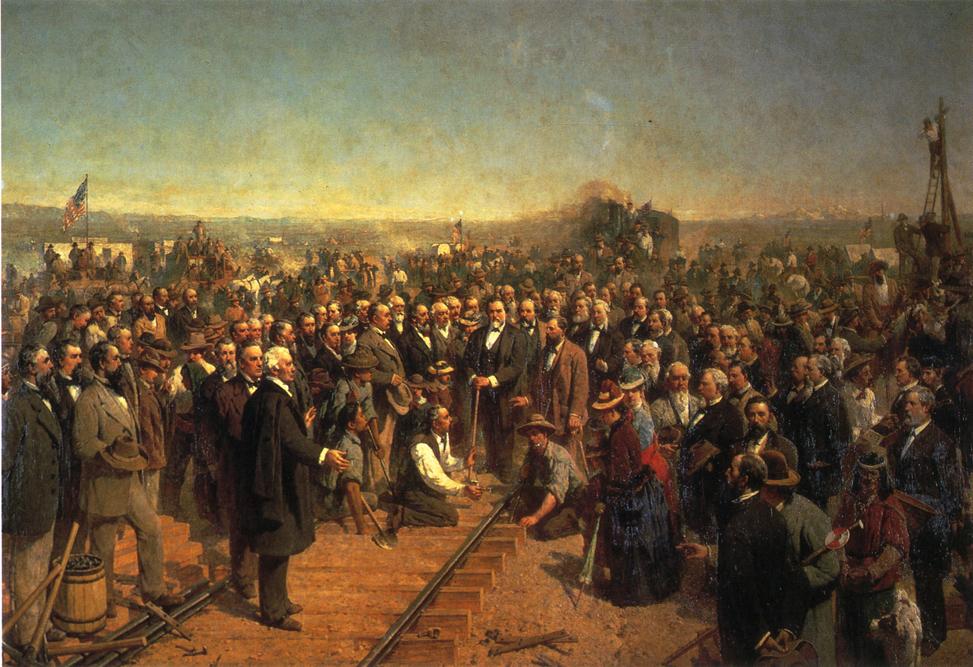The first transcontinental railroad was 1,912 miles long, and was built to connect the east and the west coasts of the United States. It was commissioned by Congress in 1862. In the 1850s Congress saw that an effective rail network connecting the east to the west was needed to help with the rapid westward settlement. Before the Civil War, Congress needed to find the best route to the Pacific, so it commissioned a number of surveyors. Both Northern states and Southern states wanted the route to begin in their regions, which kept the Senate from being able to pass any legislation on the transcontinental railroad until the Southern states seceded from the Union in 1861. With the absence of Southern legislators from Congress, the northern route to the Pacific now met with little opposition. On July 1, 1862, the Pacific Railway Act became law and it offered incentives to men who were willing to help develop this first transcontinental railway. The two railway companies that were authorized to construct the rail network was the Union Pacific and the Central Pacific Railroad Companies. They were given government bonds and vast land grants.1
The Central Pacific was founded in 1861 by a group of California merchants known as the big four: Collis P. Huntington, Leland Stanford, Mark Hopkins, and Charles Crocker. They were best known for building the part of the transcontinental railroad that started in Sacramento, California, with Huntington representing the company in the East, handling the financing and purchasing aspects, and acting as a lobbyist. Crocker was in charge of the construction aspects, and Stanford, who was the governor of California in 1862–63, saw to the company’s financial and political interests in the West. To see to their need for labor, they employed thousands of Chinese laborers who made up between 80-90% of the Central Pacific work force, to work their way through the Sierra Nevada mountain range to meet the Union Pacific on the other side.2

With the Central Pacific building from the west, the Union Pacific was building from the east to meet up with them. The Union Pacific was incorporated by the Pacific Railway Act as well. It built 1,006 miles of track westward from Omaha Nebraska to meet the Central Pacific in Promontory, Utah, on May 10, 1869. Federal loans and land grants largely financed the company, like the Central Pacific, but the Union Pacific became embroiled in scandal when its financial branch, the Crédit Mobilier, was discovered to have individuals amassing enormous amounts of profits at the public expense. After discovery of this scandal of government funds, it almost destroyed the company. It still had a huge amount of debt in 1893, when it went under new ownership.3

Despite the scandal, the first transcontinental railroad was finally connected at Promontory, Utah on May 10, 1869 with an elaborate ceremony. Thomas Durant of the Union Pacific and governor Stanford of the Central Pacific took turns hammering the final “golden spike” into the ties that united the railways. As the celebration ended and the railroad was open for business, the impact was felt immediately as the travel time between the east and west was dramatically reduced from a few months to a simple week or less.4 The impact that this had on the United States was significant. It shortened the travel time and expanded interstate trade. It helped to spread ideas, and it also helped spread American culture, as the American people saw manifest destiny take on a very real form.
- Gale Encyclopedia of American Law, 2010, s.v. “Pacific Railroad Act,” edited by Donna Batten. ↵
- Development of the Industrial U. S. Reference Library, 2006, s.v. “Biographies,” Eds. Sonia G. Benson, Jennifer York Stock, and Carol Brennan. ↵
- Gale Encyclopedia of U.S. Economic History, 2000, s.v. “Union Pacific Railroad Company.” ↵
- Dictionary of American History, 2003, s.v. “Promontory Point,” by Oscar Osbur Winther. ↵



42 comments
Faisal Alqarni
Your article on the First transcontinental rail road is very informative and detailed. The fact that the South and North fought to have it start in their regions showed its significant because before this mode of transport that cut across from the East to the west coast I cannot imagine the long time it took to travel between states on horses and other rudimentary methods. I was surprised to learn that the Chinese they are responsible for building most of the railway in America, funny thing is that in my own country they have also contributed a lot to the building of the railways to the present day. I believe this train route really helped to improve the connectivity and togetherness of the union especially after the civil war.
Alyssa Vela
This article was very informative! The length of time it took to work on a railroad was longer than i had anticipated.. 16 years, wow! Another thing that surprised me was the fact that the Chinese took up most of the construction for the railroad. Imagining how important trains/railroads were at one point in time is crazy! I come from a small town and see the trains as a nuisance now, but there’s no telling how my point of view would be had it been in the late 1800’s(more than likely it would be very different). I look forward to reading more of your work!
Briana Bustamante
Very good article! There was so much information that I was unfamiliar with. It crazy think how different life and society would be if it railroads had never been invented. Unbelievable that it changed life so much that you could travel the country in weeks, rather than months. The pictures you chose really brought life and meaning to your article. Over all very informative article!
Tyler Sleeter
Great information in this article. I had studied the transcontinental railroad in high school, but did not realize that it had taken so long to build and that there was financial scandal involved in the building. I think the railroad was an amazing feat given the technology of the time, and thought it almost miraculous that the builders were not off a centimeter or so when it came together. The building of the transcontinental railroad changed the face of America and was vital to the spread of people and business across the country.
Erick Martinez
Good article, I had little prior knowledge of the first transcontinental railroad and its importance to the advances in America at that time. This very large railroad that took 16 years to complete changed transportation completely. It was a very effective means of trade and benefited the economy. It is always interesting to learn of how we have continued to make advances to better our lives, and be more efficient in the tasks we accomplish.
Bailey Rider
This was a very informative article. It was crazy to learn about how the transcontinental railwailroad changed America so much. It’s cool how it facilitated the spread of new ideas and information! 1912 miles is a long distance for building a railroad. 16 years is such a long time though, however considering the distance, then it’s super fast! Thank you for the article!
Mario Sosa
I can only imagine how hard it must have been for those people to build railroads across the entire country in just 16 years. I too believe that the construction of the transcontinental railroads was vital in connecting the east to the west. It is also worth mentioning that time zones were implemented in the U.S. as a result of the transcontinental railroads. Great job on the article, keep up the good work!
Lianna Ybarra
I had heard of the big four before but I didn’t know they were a reason why the railroads exist. I also have a friend who works for Union Pacific so I thought it was interesting to find out a little more about them and how they started. The transcontinental railroad was such a pivotal movement in United States history because it allowed goods and things to be transported to different sides of the country in such little time compared to the time it used to take. If the railroad wasn’t developed, I wonder how long it would’ve taken them to figure something out that worked like this for transportation.
Gabriela Serrato
This was a very nice and informative article. It is always nice to learn history such as this that revolutionized the country in ways. The introduction of this railroad did of course change the country for the greater, by allowing travel time to decrease dramatically, and this modernization of transportation allowed for the country to grow and thrive as well. It is crazy to think about how in this time the railroad was so remarkable, but now we have advanced as far as cars and airplanes. It is articles like this that really make one appreciate history and how far this country has come.
Elizabeth Garibay
Very informative article! It’s interesting to read how important the railroad was to the country back then. Of course now its used for a good cause but its also crazy to think that nowadays many people have never even been on a train. Also, to me it was really surprising to find out that that the Chinese were the ones that took up most of the construction for the railroad. I had no idea but overall great information.